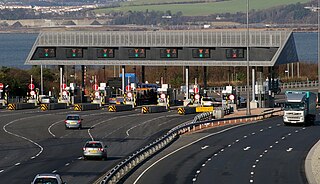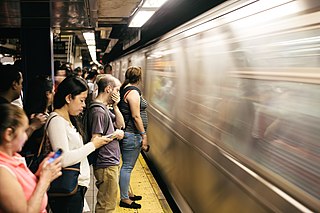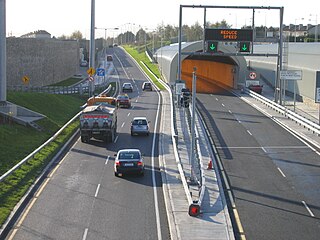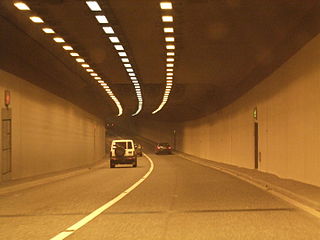
A high-occupancy vehicle lane is a restricted traffic lane reserved for the exclusive use of vehicles with a driver and at least one passenger, including carpools, vanpools, and transit buses. These restrictions may be only imposed during peak travel times or may apply at all times. There are different types of lanes: temporary or permanent lanes with concrete barriers, two-directional or reversible lanes, and exclusive, concurrent, or contraflow lanes working in peak periods.

The Dartford–Thurrock River Crossing, commonly known as the Dartford Crossing and until 1991 the Dartford Tunnel, is a major road crossing of the River Thames in England, carrying the A282 road between Dartford in Kent in the south and Thurrock in Essex in the north.

A toll road, also known as a turnpike or tollway, is a public or private road for which a fee is assessed for passage. It is a form of road pricing typically implemented to help recoup the costs of road construction and maintenance.

The Lincoln Tunnel is an approximately 1.5-mile-long (2.4 km) tunnel under the Hudson River, connecting Weehawken, New Jersey, to the west with Midtown Manhattan in New York City to the east. It carries New Jersey Route 495 on the New Jersey side and unsigned New York State Route 495 on the New York side. It was designed by Ole Singstad and named after Abraham Lincoln. The tunnel consists of three vehicular tubes of varying lengths, with two traffic lanes in each tube. The center tube contains reversible lanes, while the northern and southern tubes exclusively carry westbound and eastbound traffic, respectively.

The Queensway Tunnel is a road tunnel under the River Mersey, in the north west of England, between Liverpool and Birkenhead. Locally, it is often referred to as the "Birkenhead Tunnel" or "old tunnel", to distinguish it from the newer Kingsway Tunnel (1971), which serves Wallasey and the M53 motorway traffic. At 3.24 kilometres (2.01 mi) in length, it is the longest road tunnel in the UK.

The Holland Tunnel is a vehicular tunnel under the Hudson River that connects Hudson Square and Lower Manhattan in New York City in the east to Jersey City, New Jersey in the west. The tunnel is operated by the Port Authority of New York and New Jersey and carries Interstate 78. The New Jersey side of the tunnel is the eastern terminus of New Jersey Route 139. The Holland Tunnel is one of three vehicular crossings between Manhattan and New Jersey; the two others are the Lincoln Tunnel and George Washington Bridge.

The London congestion charge is a fee charged on most cars and motor vehicles being driven within the Congestion Charge Zone (CCZ) in Central London between 7:00 am and 6:00 pm Monday to Friday, and between 12:00 noon and 6:00 pm Saturday and Sunday.

Road pricing are direct charges levied for the use of roads, including road tolls, distance or time-based fees, congestion charges and charges designed to discourage the use of certain classes of vehicle, fuel sources or more polluting vehicles. These charges may be used primarily for revenue generation, usually for road infrastructure financing, or as a transportation demand management tool to reduce peak hour travel and the associated traffic congestion or other social and environmental negative externalities associated with road travel such as air pollution, greenhouse gas emissions, visual intrusion, noise pollution and road traffic collisions.

The Blackwall Tunnel is a pair of road tunnels underneath the River Thames in east London, England, linking the London Borough of Tower Hamlets with the Royal Borough of Greenwich, and part of the A102 road. The northern portal lies just south of the East India Dock Road (A13) in Blackwall; the southern entrances are just south of The O2 on the Greenwich Peninsula. The road is managed by Transport for London (TfL).

The Rotherhithe Tunnel, designated the A101, is a road tunnel under the River Thames in East London, connecting Limehouse in the London Borough of Tower Hamlets north of the river to Rotherhithe in the London Borough of Southwark south of the river. It was formally opened in 1908 by George, Prince of Wales, and Richard Robinson, Chairman of the London County Council. It is a rare example of a road tunnel where road traffic, pedestrians and cyclists all share the same tunnel bore. Transport for London took over ownership and maintenance of the tunnel in 2001.

Electronic toll collection (ETC) is a wireless system to automatically collect the usage fee or toll charged to vehicles using toll roads, HOV lanes, toll bridges, and toll tunnels. It is a faster alternative which is replacing toll booths, where vehicles must stop and the driver manually pays the toll with cash or a card. In most systems, vehicles using the system are equipped with an automated radio transponder device. When the vehicle passes a roadside toll reader device, a radio signal from the reader triggers the transponder, which transmits back an identifying number which registers the vehicle's use of the road, and an electronic payment system charges the user the toll.

Carpooling is the sharing of car journeys so that more than one person travels in a car, and prevents the need for others to have to drive to a location themselves. Carpooling is considered a Demand-Responsive Transport (DRT) service.

A rush hour or peak hour is a part of the day during which traffic congestion on roads and crowding on public transport is at its highest. Normally, this happens twice every weekday: once in the morning and once in the afternoon or evening, the times during which most people commute. The term is often used for a period of peak congestion that may last for more than one hour.

EastLink is a tolled section of the M3 freeway linking a large area through the eastern and south-eastern suburbs of Melbourne, Australia.

The Dublin Tunnel, originally and still commonly known as the Port Tunnel, is a road traffic tunnel in Dublin, Ireland, that forms part of the M50 motorway.

The Jack Lynch Tunnel is an immersed tube tunnel and an integral part of the N40 road network in Cork, Ireland. It is named after former Taoiseach, Jack Lynch, a native of Cork.

The Cross City Tunnel is a 2.2-kilometre long (1.4 mi) twin-road tunnel tollway located in Sydney, New South Wales, Australia. The tunnel links Darling Harbour on the western fringe of the central business district to Rushcutters Bay in the Eastern Suburbs. Each of the twin tunnels has a different alignment, with the westbound tunnel running underneath William and Park streets and the eastbound tunnel running underneath Bathurst Street.

The Baltimore Harbor Tunnel is a pair of two-lane road tunnels carrying I-895 under the Patapsco River southeast of downtown Baltimore, Maryland.

Motoring taxation in the United Kingdom consists primarily of vehicle excise duty, which is levied on vehicles registered in the UK, and hydrocarbon oil duty, which is levied on the fuel used by motor vehicles. VED and fuel tax raised approximately £32 billion in 2009, a further £4 billion was raised from the value added tax on fuel purchases. Motoring-related taxes for fiscal year 2011/12, including fuel duties and VED, are estimated to amount to more than £38 billion, representing almost 7% of total UK taxation.

The Western Scheldt Tunnel is a 6.6-kilometre (4.1 mi) tunnel in the Netherlands that carries highway N62 under the Western Scheldt estuary between Ellewoutsdijk and Terneuzen. It is the longest tunnel for highway traffic in the Netherlands.





















